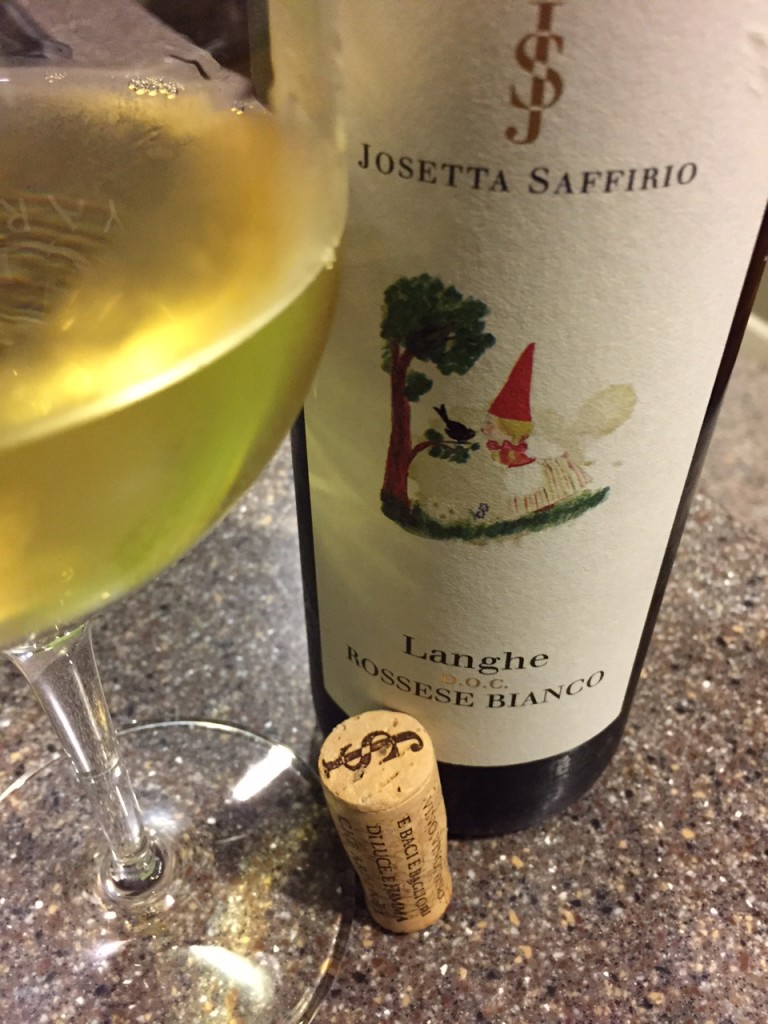Rossese Bianco is a grape native to the Cinque Terra region of Italy. It made its way to the Langhe in the late nineteenth century, and was rediscovered in old vineyards of Monforte in the mid 70s. The Langhe Rossese Bianco DOC was established in 2011, acknowledging it as a grape variety native to Piedmont.
The grapes are hand-picked in late September, then de-stemmed and crushed . Thereafter the juice is stored for temperature controlled cryo-soaking tubs. Fermentation takes place partly in stainless steel and partly in oak barrels at cellar temperature. After fermentation, the wine is left on its lees with frequent batonnage until malo-lactic fermentation occurred. Batonnage continues as the wine matures for about 9 months.
My tasting notes follow:
The wine pours a brilliant lemon gold color with stone fruit, lemon curd, white flower and a bit of dried herb and wet stone aromas. On the palate between light and medium-bodied, very fresh with great texture, and well-balanced alcohol and subtle soft tannins with baked nectarine, winter melon, lemon, key lime and a hint of passion fruit flavors with very giving mineral driven finish accented with a bit of salinity. (Very Good to Outstanding; 89-90 pts.)
Pair with: Seafood and shellfish and mature cheeses. Here’s a couple of dishes I’d love to try with this alluring wine; Spaghetti with Clams and Garlic, or Warm Seafood Salad with Pistachio and Capers
14% abv | $14(sample)
About Josetta Saffririo
Josetta Saffirio Wines is a boutique family and female owned winery located in Piedmont, Monforte d’Alba.
At the beginning of the twentieth century Ernesto Saffirio began to cultivate vineyard he inherited from his father. In 1975 his daughter Josetta, a teacher at the School of Enology in Alba, and her husband Roberto Vezza, also an enologist took over the to take charge of caring for his vineyards planted by her grandparents after World War II. With the ambitious goal of producing great Barolo from their vineyards, a decade later they produced the first wine under the Josetta Saffirio label.
Soon thereafter their hard work was recognized. They earned the highest honor, ‘Three Glasses’ from the Gambero Rosso for their 1988 and 1989 Barolo.
As the small estate was developing, Dolcetto and Barbera were added into the vineyards. and as once Josetta’s father, Ernesto, passed his vines on to the next generations, these new vineyards were in turn dedicated to Josetta and Roberto’s children, Sara and Alessio.
In 1997 Sara made the decision to return to the home winery and was the driving force behind the decision to start bottling again in 1999,
Under her leadership a new sustainable cellar was built in 2006. It is fully integrated with the surroundings and isolated with the natural cork. Additionally Josetta Saffirio Wines has focused on new sustainable solutions with technologies like a photovoltaic system; reduction of CO2 and oil production. The winery attained its Sustainable certification in 2015, and is currently seeking its organic certification.
About the Gnomes
When Josetta was a child, her father Ernesto told her that he saw a gnome in a cart pulled by mice. As the story went, the gnomes helped the farmers take care of their animals and the cellars in exchange for a little wine.
Gnomes are the conscience of honest men – Josetta Saffirio website
Josetta continued the family tradition of the tale of the gnomes with her children Sara and Alessio. The gnomes, which represent wholesomeness and sweetness are dedicated to her children. She created all illustrations that adore the label of her wines.
Find more information about the winery and vineyard here
________________________________________________________________________
Follow me on Twitter,Facebook,Instagram, Vivino and Delectable, for all things wine. As a wino with latent foodie tendencies, you’ll also find food and wine pairings, and food related stuff! Become a fan and join ENOFYLZ Wine Blog on Facebook. Cheers! This article is original to ENOFYLZ Wine Blog.com. Copyright 2016 ENOFYLZ Wine Blog. All rights reserved.

Nice article, Martin. I’ve been on a bit of an Italian jag lately, and this wine sounds like one I should try. Thanks for posting!